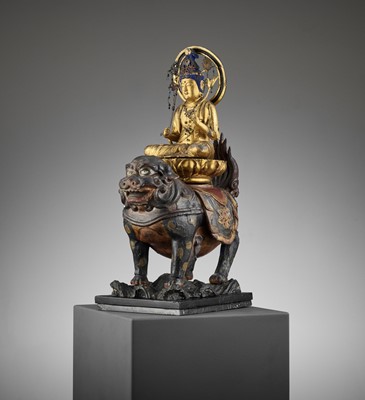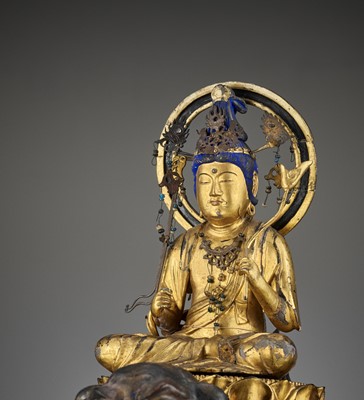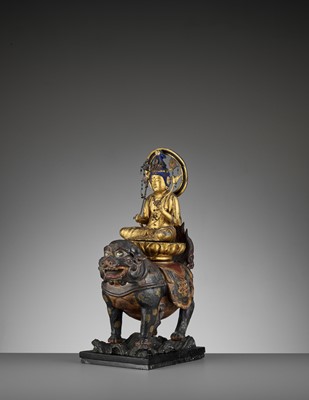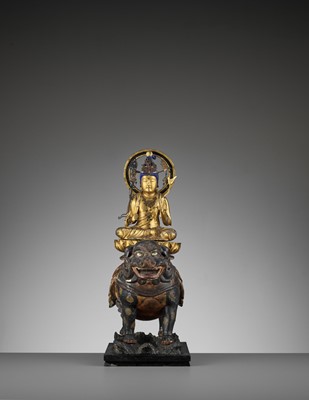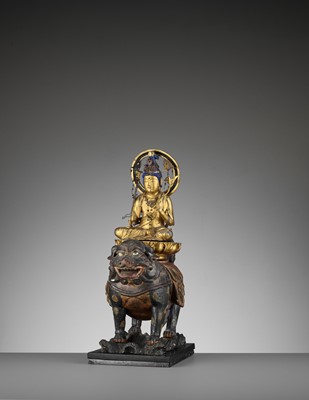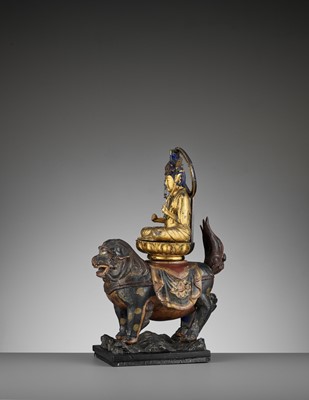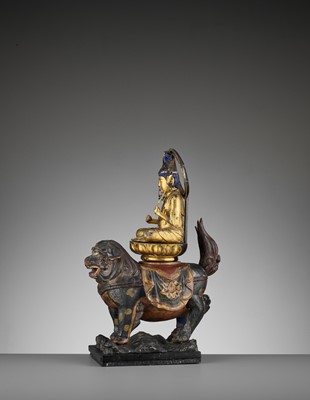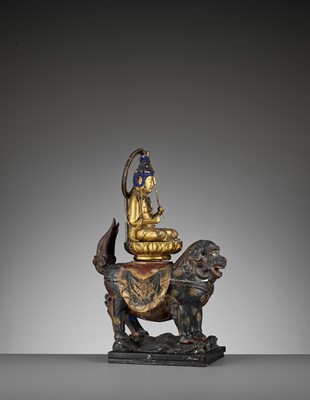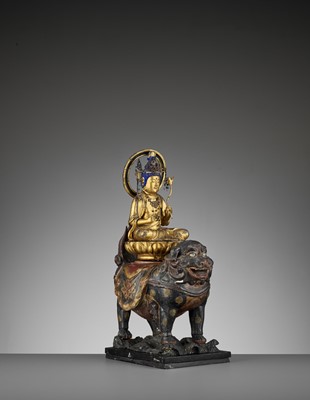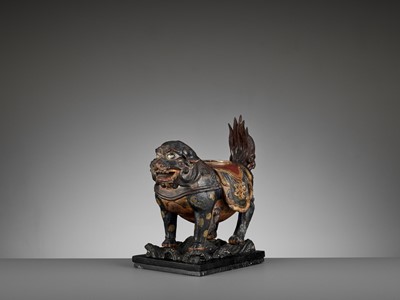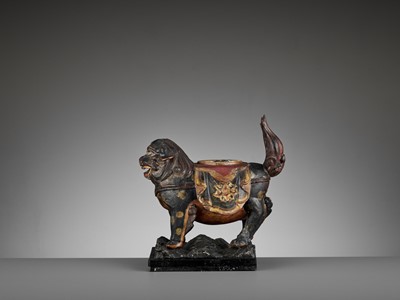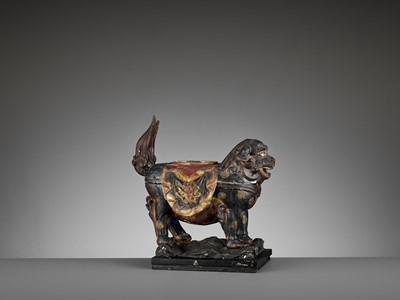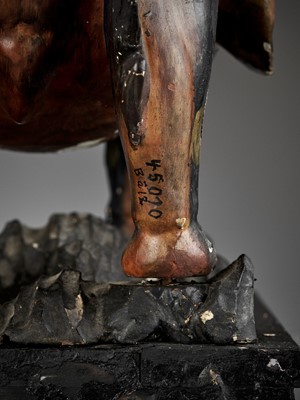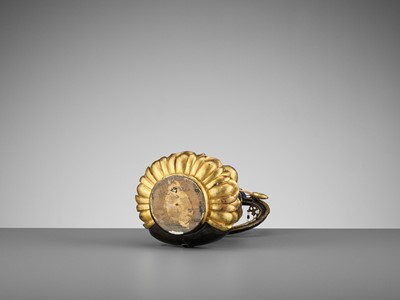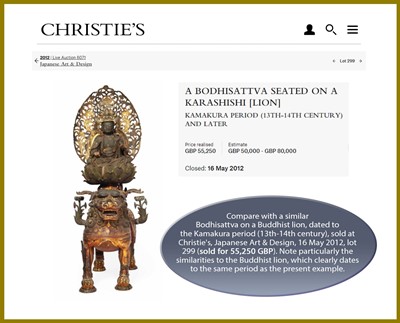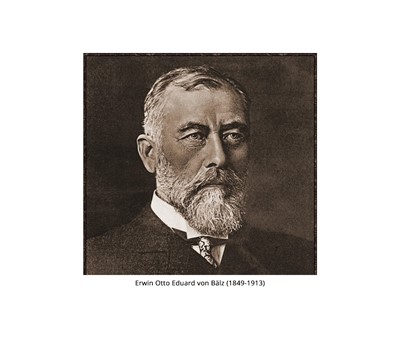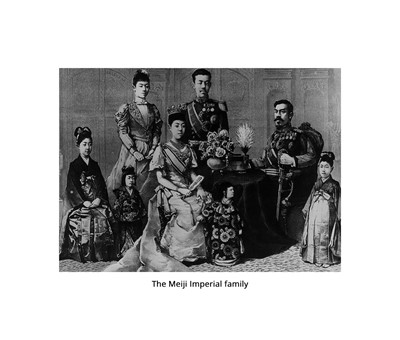4th Jun, 2021 13:00
Fine Japanese Art
124
A RARE GILT AND LACQUERED WOOD STATUE OF MONJU BOSATSU ON A KAMAKURA PERIOD BUDDHIST LION
Sold for €8,848
including Buyer's Premium
Japan, the Bosatsu figure dating from the Edo period (17th to early 18th century), the lion dating from the late Kamakura to earlier Muromachi period (13th-15th century)
Seated in vajrasana on a lotus throne, which itself rests on the back of a ferocious lion standing foursquare and with its mouth wide open. Bosatsu’s left holds a blossoming lotus. He wears a pleated skirt, a shawl on his shoulders, and an elegant scarf across his chest. His serene face with its half-closed eyes, the aquiline nose, the slender mouth, the dominant forehead adorned with an urna, and the hair combed into a high chignon overall show a distinct benevolent expression.
Condition: Significant traces of use, old wear, touchups, age cracks and losses. Possibly minor old replacements. Generally in fine condition, overall commensurate with age.
Provenance: Figure and base each with old collector inventory inscriptions "45010 Bälz" and "45010 Japan Bälz". According to these inscriptions from the ancient collection of Erwin Bälz (1849-1913). Collection of Dr. Erich Junkelmann (1890-1964), Lustheim Castle, Bavaria, by repute acquired from the above. Private collection, Southern Germany, by repute acquired from the above. Erwin Otto Eduard von Bälz (13 January 1849 – 31 August 1913) was a German internist, anthropologist, and the personal physician to the Japanese Imperial Family.
HEIGHT 48.5 cm
The head adorned by a matching gilt-bronze openwork crown, neatly incised and inlaid in glass, all backed by a circular wood halo. Note the distinct ‘Ruyi’ shape of the lion's nose, typical for the period, as well as the original inside-painted glass eyes.
Literature comparison:
Compare the manner of the carving of the Buddhist lion with a closely related example from the Kamakura period in the Nara National Museum, accession no. 1311-0.
Auction comparison:
Compare with a similar Bodhisattva on a Buddhist lion, dated to the Kamakura period (13th-14th century), sold at Christie's, Japanese Art & Design, 16 May 2012, lot 299 (sold for 55,250 GBP). Note particularly the similarities to the Buddhist lion, which clearly dates to the same period as the present example.
Japan, the Bosatsu figure dating from the Edo period (17th to early 18th century), the lion dating from the late Kamakura to earlier Muromachi period (13th-15th century)
Seated in vajrasana on a lotus throne, which itself rests on the back of a ferocious lion standing foursquare and with its mouth wide open. Bosatsu’s left holds a blossoming lotus. He wears a pleated skirt, a shawl on his shoulders, and an elegant scarf across his chest. His serene face with its half-closed eyes, the aquiline nose, the slender mouth, the dominant forehead adorned with an urna, and the hair combed into a high chignon overall show a distinct benevolent expression.
Condition: Significant traces of use, old wear, touchups, age cracks and losses. Possibly minor old replacements. Generally in fine condition, overall commensurate with age.
Provenance: Figure and base each with old collector inventory inscriptions "45010 Bälz" and "45010 Japan Bälz". According to these inscriptions from the ancient collection of Erwin Bälz (1849-1913). Collection of Dr. Erich Junkelmann (1890-1964), Lustheim Castle, Bavaria, by repute acquired from the above. Private collection, Southern Germany, by repute acquired from the above. Erwin Otto Eduard von Bälz (13 January 1849 – 31 August 1913) was a German internist, anthropologist, and the personal physician to the Japanese Imperial Family.
HEIGHT 48.5 cm
The head adorned by a matching gilt-bronze openwork crown, neatly incised and inlaid in glass, all backed by a circular wood halo. Note the distinct ‘Ruyi’ shape of the lion's nose, typical for the period, as well as the original inside-painted glass eyes.
Literature comparison:
Compare the manner of the carving of the Buddhist lion with a closely related example from the Kamakura period in the Nara National Museum, accession no. 1311-0.
Auction comparison:
Compare with a similar Bodhisattva on a Buddhist lion, dated to the Kamakura period (13th-14th century), sold at Christie's, Japanese Art & Design, 16 May 2012, lot 299 (sold for 55,250 GBP). Note particularly the similarities to the Buddhist lion, which clearly dates to the same period as the present example.
Zacke Live Online Bidding
Our online bidding platform makes it easier than ever to bid in our auctions! When you bid through our website, you can take advantage of our premium buyer's terms without incurring any additional online bidding surcharges.
To bid live online, you'll need to create an online account. Once your account is created and your identity is verified, you can register to bid in an auction up to 12 hours before the auction begins.
Intended Spend and Bid Limits
When you register to bid in an online auction, you will need to share your intended maximum spending budget for the auction. We will then review your intended spend and set a bid limit for you. Once you have pre-registered for a live online auction, you can see your intended spend and bid limit by going to 'Account Settings' and clicking on 'Live Bidding Registrations'.
Your bid limit will be the maximum amount you can bid during the auction. Your bid limit is for the hammer price and is not affected by the buyer’s premium and VAT. For example, if you have a bid limit of €1,000 and place two winning bids for €300 and €200, then you will only be able to bid €500 for the rest of the auction. If you try to place a bid that is higher than €500, you will not be able to do so.
Online Absentee and Telephone Bids
You can now leave absentee and telephone bids on our website!
Absentee Bidding
Once you've created an account and your identity is verified, you can leave your absentee bid directly on the lot page. We will contact you when your bids have been confirmed.
Telephone Bidding
Once you've created an account and your identity is verified, you can leave telephone bids online. We will contact you when your bids have been confirmed.
Classic Absentee and Telephone Bidding Form
You can still submit absentee and telephone bids by email or fax if you prefer. Simply fill out the Absentee Bidding/Telephone bidding form and return it to us by email at office@zacke.at or by fax at +43 (1) 532 04 52 20. You can download the PDF from our Upcoming Auctions page.
How-To Guides
How to Create Your Personal Zacke Account
How to Register to Bid on Zacke Live
How to Leave Absentee Bids Online
How to Leave Telephone Bids Online
中文版本的操作指南
创建新账号
注册Zacke Live在线直播竞拍(免平台费)
缺席投标和电话投标
Third-Party Bidding
We partner with best-in-class third-party partners to make it easy for you to bid online in the channel of your choice. Please note that if you bid with one of our third-party online partners, then there will be a live bidding surcharge on top of your final purchase price. You can find all of our fees here. Here's a full list of our third-party partners:
- 51 Bid Live
- EpaiLive
- ArtFoxLive
- Invaluable
- LiveAuctioneers
- the-saleroom
- lot-tissimo
- Drouot
Please note that we place different auctions on different platforms. For example, in general, we only place Chinese art auctions on 51 Bid Live.
Bidding in Person
You must register to bid in person and will be assigned a paddle at the auction. Please contact us at office@zacke.at or +43 (1) 532 04 52 for the latest local health and safety guidelines.
